If you’ve ever made a flimsy ramp out of a few milk crates and a wooden plank, then you did your part in furthering the legacy of real-life daredevil Evel Knievel. If you broke a few bones in the process, then you can be sure the man himself was smiling from up above as you launched into uncertainty.
Back in the 1970s, America took one Robert Craig Knievel and turned him into the maximum expression of the dream it prophesied. All it took was a motorcycle, dangerous things to jump over, and a blatant disregard for death. A legend was born, and his name was Evel Knievel. His jumps were national events that people were eager to witness on the grounds that they would either end in glorious victory or bone-shattering defeat. Now, writer Rylend Grant and artist Dave Acosta are giving the original daredevil his own comic, which is edited by Rachel E. Nelson.

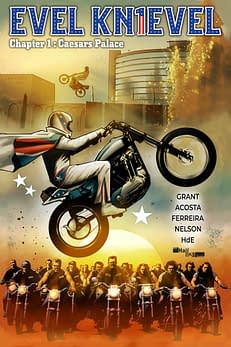
Evil Knievel #1 is currently running its funding campaign on Kickstarter, to great success thus far, and it promises to not just capture the mythical presence of the titular stunt rider but also the precarious nature of the times he was performing in.
The story follows Evel as he prepares for his iconic 1967 Ceasars Palace jump (which resulted in a crushed pelvis and several fractures). A group of outlaw motorcyclists want a cut of the earnings, and they’re willing to rough up our hero to get what they want. This is where the comic shows its 1960s-70s film influences. Movies like The Born Losers (the movie that introduced Billy Jack to the world), Walking Tall, and George Romero’s Knightriders are all echoed here in one way or another. They speak to the comic’s blend of Western sensibilities and biker gang stylings.
The Beat corresponded with writer Rylend Grant to talk Evel Knievel as a comic book character, whether he can be considered the first true influencer, and if there’s even a chance someone else could ever step into the shoes of the best stunt rider in American history.

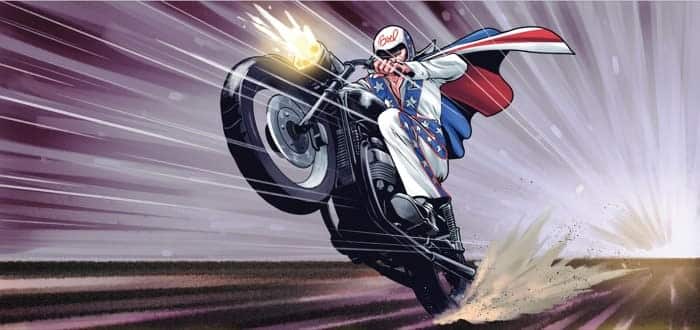
RICARDO SERRANO: Evel Knievel is a uniquely American phenomenon. Not a tight-rope performer or a risky skyscraper climber. A biker that jumped over stuff. Why do you think his persona resonated with so many people?
RYLEND GRANT: Robert Craig Knievel was just this dirtbag kid from a mining town – and I say that with all the love and respect in the world, being a dirtbag kid from a housing project in Detroit myself – but through sheer will, grit, and determination, he made himself into the most famous/recognizable man in the world. That’s the American dream, right? Come from nothing. Take the world by the balls, rip everything you want and need from it.
Evel was an inspiration to millions. He was an inspiration to me. Kids where I was born, they didn’t grow up to be Hollywood screenwriters (my day job is writing film/TV), to write high profile comic books, to be interviewed by cool people from THE BEAT. Folks where I came up lived their whole lives five minutes from where they were born. They became tow-truck drivers and plumbers because they thought they were supposed to, because they thought that’s all that was out there for them.
But I knew there was more. I knew anything was possible, because a few people like Evel Knievel showed me it was.
He was a gambler. He was a pioneer. I mean, he invented his profession. It didn’t exist before he climbed on that motorcycle and started leaping over anything they put in front of him. He was a myth-maker, a folk hero, an anti-hero before there were really anti-heroes. He was something for everybody.
Evel Knievel was such a force of nature, such a freight train of a person, that no matter when he came into being he would have become the biggest, baddest, most famous man around… but – as heroes tend to – he also emerged at the exact right time/when the world needed him most.
Vietnam was wrapping up. Watergate. The Pentagon Papers. Televangelist scandals. An oil crisis. The world was in flux. The country was divided. But here came this rock star on a motorcycle, draped in the flag, howling at the goddamn moon. He united people. He was one of the few things everyone could agree on, no matter where they came from, no matter their politics or world view. Everybody wanted to see Evel jump. No one wanted to miss it if he crashed. Everyone stopped what they were doing and shut their mouths. They watched. They listened.

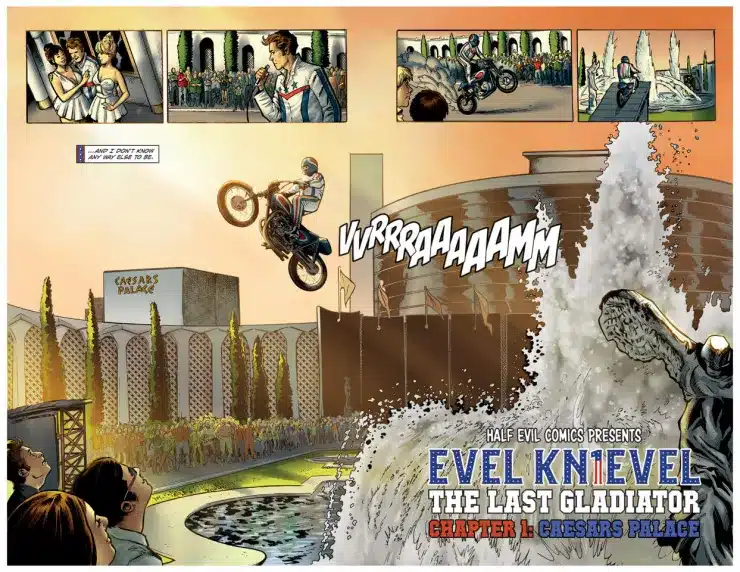
SERRANO: Any time a new movie or comic based on an iconic figure is announced, legacy rears its head. You ask yourself “why now?” It got me thinking about how Evel would’ve gone about building his story in a saturated social media landscape. Then again, he influenced so many people. I mean, kids would make a ramp out of anything and jump it with their bicycles to be like him. Was Evel Knievel a kind of proto-influencer?
GRANT: That’s such an interesting way to put it. Yes, Evel Knievel might well have been the first true influencer. He pioneered personal branding, spectacle-driven marketing, product tie-ins, everything the big deal Instagram and YouTube stars do today. He just did it with motorcycles and broken bones instead of pranks, giveaways, and girls dancing.
If you are indeed asking “why now?” I’d say it’s because the world needs him again. As a society, we are divided now more than we maybe ever have been, certainly more than we’ve been since the late 1960s when Evel stormed onto the scene. We don’t agree on much right now, but I think we can all agree on Evel. I think we all still yearn to shut up and watch someone do something inspiring and spectacular. I think we all want to cheer when a man gets back up after a catastrophic fall.
SERRANO: How does one capture the excitement of an Evel Knievel jump in comics form?
GRANT: Honestly, you just kind of have to tell it like it was and is. I’ve written a number “true” stories in my time working in Hollywood and you usually have to put a bunch of “snot” on the ball, play with the facts a little bit to make it more interesting and dramatic. But Evel was such a rich, dynamic character (such an incredible lunatic) that the real story was already much more interesting than anything you could possibly make up.
It helps that I have great collaborators. The book is being drawn by Dave Acosta who is best known for doing the Elvira books over at Dynamite. After years of work like that, he’s a master at nailing the likenesses, at setting a wicked mood, at capturing the personality of a larger-than-life character. He does a great job with those books, but I think his personal taste in media tends to skew more actioney, more kinetic. He kicks a hell of a lot more ass, so, he is just knocking this book out of the park and having more fun that any one man probably should.
We’re getting covers from Marvel/DC artist Ray-Anthony Height, Ringo Award-nominee Fabio Alves, Jon Pinto, and Flop that are just blowing my mind. And Edson Ferreira is covering the living hell out of this book.
They’re doing all of the heavy lifting on this. I just try to hold onto the proverbial handlebars.

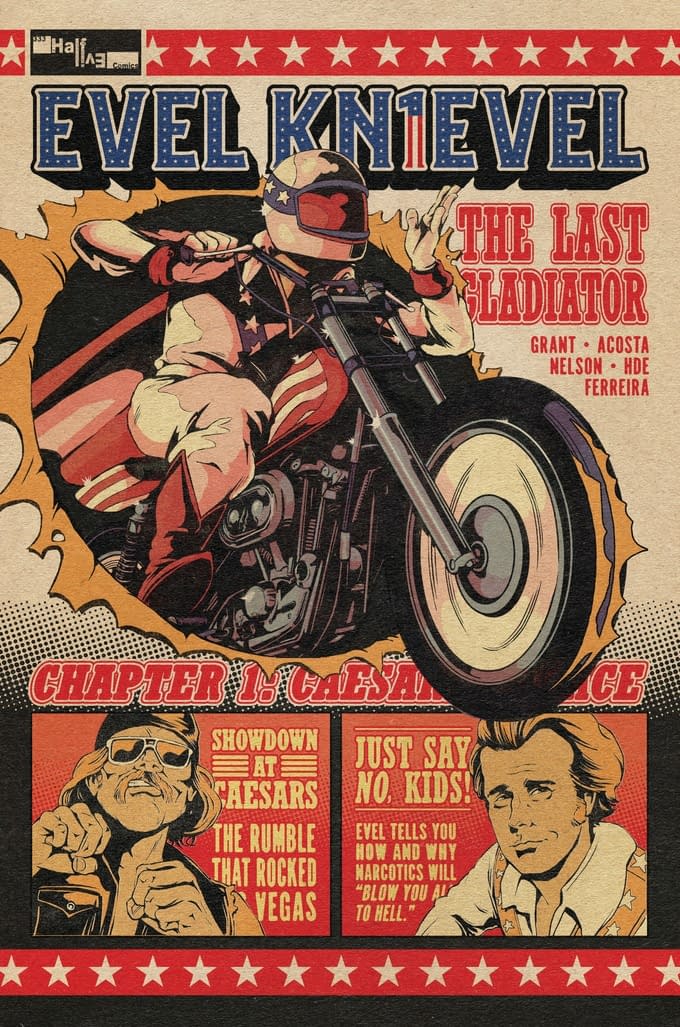
SERRANO: Do you think Evel Knievel was a once in a lifetime phenomenon? Or are we just waiting for someone to take up the mantel of the death-defying daredevil?
GRANT: Evel used to say that everyone remembers the name of the first guy to set foot on the moon, but do you know the name of the third guy to do it? Absolutely not. I think there is truth in that. He broke the ground. He poured the foundation. He built this house. The rest of us are just renting rooms and hanging out on the back patio.
That said, there are real deal bad mofos who are still carrying the motorcycle daredevil torch like Travis Pastrana and Colby Raha, and they’re amazing and fun to watch.
Let’s not forget also that we have X-Games, we have action sports because of Evel Knievel. Just ask Tony Hawk, Matt Hoffman, and Shaun White who inspired them, why they do what they do.
There will always be daredevils. People will always jump over shit on motorcycles…or bicycles…or skateboards…or snowboards. But, there will never be another world-class, hall-of-fame character like Evel Knievel. He was a one-of-one. He’s Ric Flair. He’s Frank Sinatra. He’s Elvis. He’s Liberace. But he’s cooler than those guys and could steal their girlfriends. And none of those guys ever had to contend with hitting pavement at 100 mph.

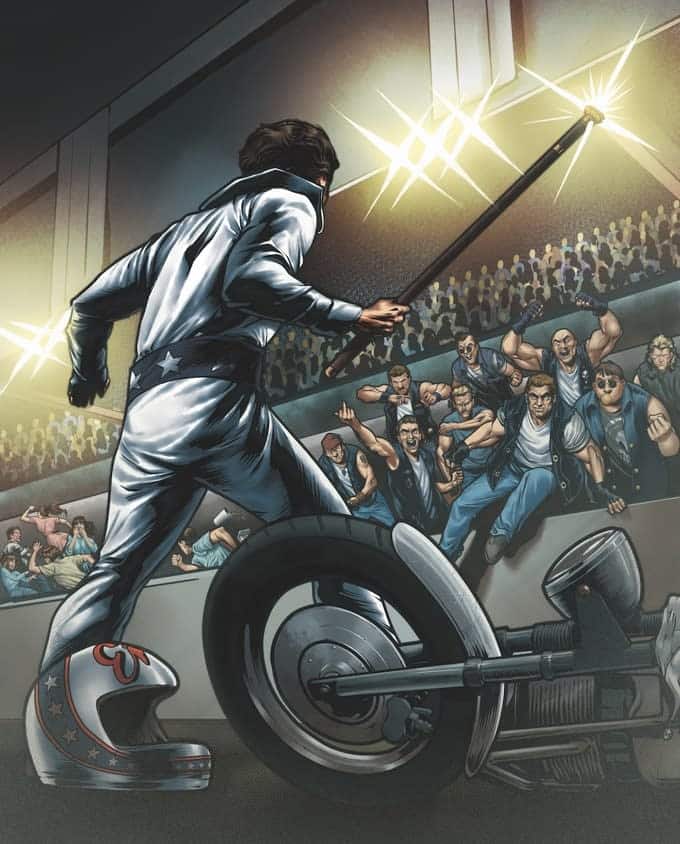
SERRANO: How do you see Evel Knievel evolving as a comic book character?
GRANT: There are things that aren’t said enough, things the world maybe doesn’t know about him. Evel’s real-life story is one of redemption more than anything. Robert Craig Knievel created this “Evel” persona and then – as he was fond of saying – it kind of got away from him. For many, that’s where his story ends. A lot of folks don’t know what came next. They don’t know that he came back to family, to love, to hope, to good. He stood up for what he believed in, what was right. He fought for the little guy, for every guy. He worked every day to bring people together. More than anything, we want to show that. We want people to leave with that. This man was a real-life comic book hero, through and through. There is no better man, woman, child, or super-powered individual to make a book about.



